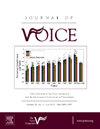Relationships Between Sense of Coherence, Self-perception of Voice and Work Environment Among Teachers
IF 2.5
4区 医学
Q1 AUDIOLOGY & SPEECH-LANGUAGE PATHOLOGY
引用次数: 0
Abstract
Objective
to analyze the relationship between sense of coherence and sociodemographic data, remote physical work environment, and self-perception of symptoms, vocal handicap and vocal fatigue in teachers.
Methods
Seventy eight teachers pertaining to the municipal education network of a Brazilian capital city participated in the study, during the period of social isolation by COVID-19. An online questionnaire was applied with sociodemographic and physical remote work environment questions, the Sense of Coherence Scale (SOC-13), the Brazilian Dysphonia Screening Tool (Br-DST), the Vocal Fatigue Index (VFI), and the Vocal Handicap Index (VHI-10). Descriptive analysis, bivariate and multivariate Logistic regression models were performed to check the proportion of teachers with high and low SOC among the different categories of independent variables. Student's t test and Mann Whitney test were used to compare SOC, IDV, and VFI scores between the groups, and Hedge's g test was used to access the effect size. The total scores of SOC, VHI and VFI were correlated using Pearson's Correlation Coefficient. All tests adopted a 5% significance level.
Results
Male teachers and those over 45 years old were, respectively, 6.79 (95%CI = 1.16-39.58) and 5.27 (95%CI = 1.40-19.76) times more likely to present a high SOC. The variables associated with a lower chance of presenting high SOC were vocal restriction (OR = 0.21; 95%CI = 0.06-0.79) and voice-related physical discomfort (OR = 0.13; 95%CI = 0.02-0.78). Regarding the remote work environment, in bivariate analysis, teachers who were dissatisfied with air quality (OR = 0.08; 95%CI = 0.01-0.65), temperature (OR = 0.11; 95%CI = 0.01-0.92), and noise (OR = 0.25; 95%CI = 0.61-0.99) were less likely to have high SOC. Higher values of SOC are associated with lower self-perception of vocal fatigue and voice handicap (P < 0,001).
Conclusion
The way individuals face stressful situations interferes with the self-perception of their voice and their work environment. The relationship between the sense of coherence and voice perception is relevant to favor programs to promote vocal health and stress management in teachers.
教师的连贯感、自我声音感与工作环境之间的关系。
目的:分析教师的协调感与社会人口学数据、远程物理工作环境、自我感觉症状、发声障碍和发声疲劳之间的关系:在 COVID-19 的社会隔离期,巴西首都某市教育网络的 78 名教师参与了研究。研究采用了一份在线问卷,其中包括社会人口学和偏远地区物理工作环境问题、连贯性量表(SOC-13)、巴西发音障碍筛查工具(Br-DST)、声带疲劳指数(VFI)和声带障碍指数(VHI-10)。通过描述性分析、二元和多元 Logistic 回归模型来检验不同类别自变量中 SOC 高和 SOC 低的教师比例。采用学生 t 检验和曼-惠特尼检验来比较各组之间的 SOC、IDV 和 VFI 分数,并采用 Hedge's g 检验来获取效应大小。采用皮尔逊相关系数对 SOC、VHI 和 VFI 的总分进行相关分析。所有检验均采用 5%的显著性水平:男性教师和 45 岁以上的教师出现高 SOC 的几率分别是男性教师的 6.79 倍(95%CI = 1.16-39.58)和男性教师的 5.27 倍(95%CI = 1.40-19.76)。与出现高 SOC 的几率较低相关的变量是发声限制(OR = 0.21;95%CI = 0.06-0.79)和与嗓音相关的身体不适(OR = 0.13;95%CI = 0.02-0.78)。关于远程工作环境,在二元分析中,对空气质量(OR = 0.08;95%CI = 0.01-0.65)、温度(OR = 0.11;95%CI = 0.01-0.92)和噪音(OR = 0.25;95%CI = 0.61-0.99)不满意的教师不太可能有较高的 SOC 值。SOC值越高,嗓音疲劳和嗓音障碍的自我感觉越低(P < 0,001):结论:个人面对压力情境的方式会干扰其对嗓音和工作环境的自我感知。协调感与嗓音感知之间的关系对促进教师嗓音健康和压力管理计划具有重要意义。
本文章由计算机程序翻译,如有差异,请以英文原文为准。
求助全文
约1分钟内获得全文
求助全文
来源期刊

Journal of Voice
医学-耳鼻喉科学
CiteScore
4.00
自引率
13.60%
发文量
395
审稿时长
59 days
期刊介绍:
The Journal of Voice is widely regarded as the world''s premiere journal for voice medicine and research. This peer-reviewed publication is listed in Index Medicus and is indexed by the Institute for Scientific Information. The journal contains articles written by experts throughout the world on all topics in voice sciences, voice medicine and surgery, and speech-language pathologists'' management of voice-related problems. The journal includes clinical articles, clinical research, and laboratory research. Members of the Foundation receive the journal as a benefit of membership.
 求助内容:
求助内容: 应助结果提醒方式:
应助结果提醒方式:


